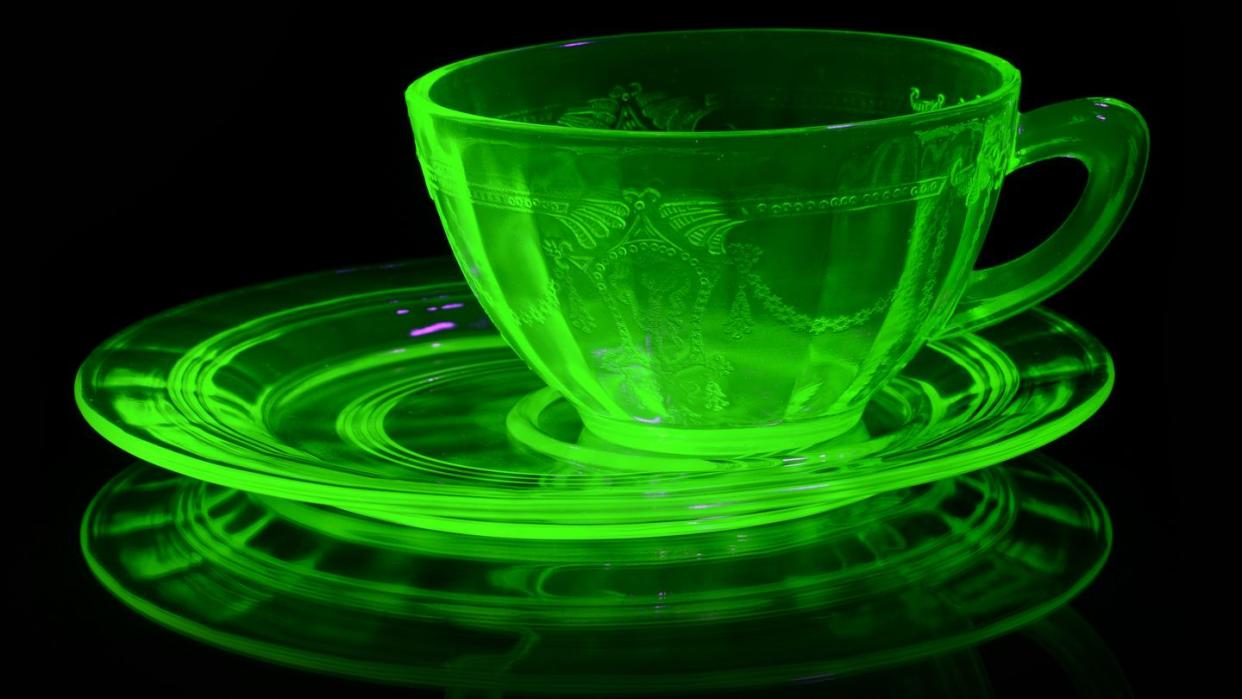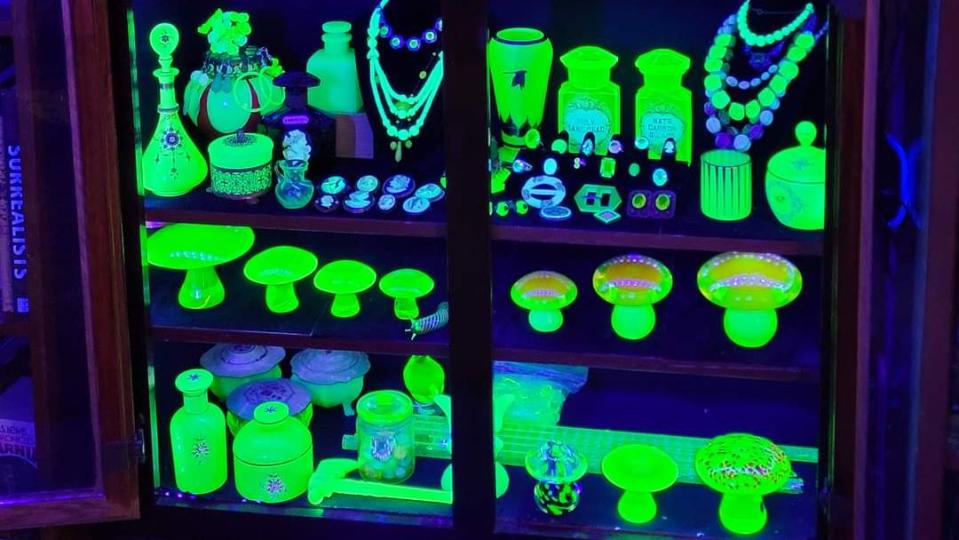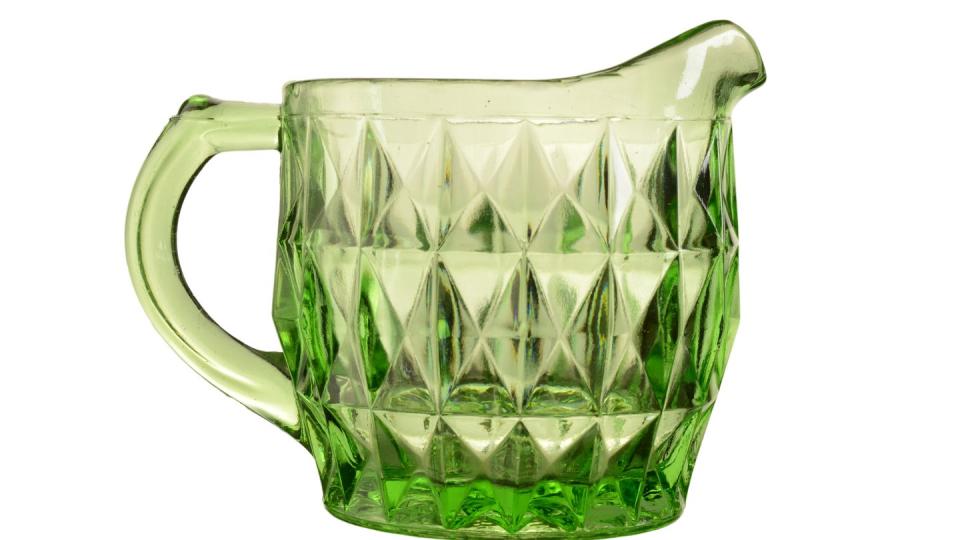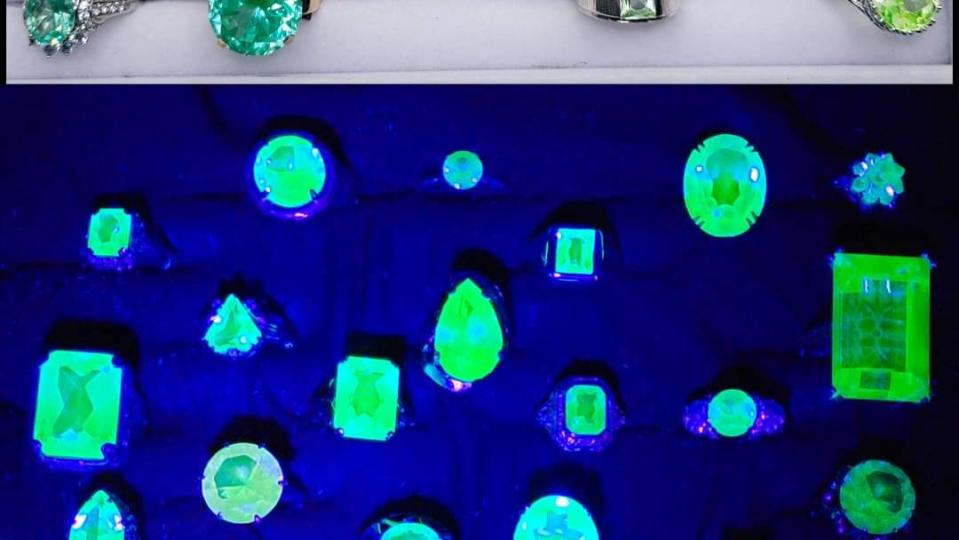The Weird and Wonderful World of Radioactive Glassware Collecting

When Sarah Cooper goes secondhand shopping, she brings a little blacklight with her and shines it on everything—candlesticks, vases, dishware. If it starts glowing, often a Ghostbusters hue of neon green, then she knows she's found the treasure she was seeking. It's a thrift store gem: Vintage uranium glass.
"I love uranium glass because of the bright glow it gives not only in direct sunlight but also when under a blacklight," says Cooper, who has a collection displayed in the sitting parlor of her Fostoria, Ohio home.
Cooper is among the nearly 3 million members of a Facebook group called "Weird and Wonderful Secondhand Finds That Just Need to Be Shared." And one of that group's favorite finds is uranium glass

What Is Uranium Glass?
According to The Glass Museum, the glow-in-the dark glassware is believed to have been invented by glassmaker Josef Riedel, who used uranium to color glassware in his factory in Bohemia in the mid 1800s. It became popular in the U.S. and uranium was widely used to color glassware until 1943, when the government started regulating its use so that they could save uranium to build atom bombs. According to Michigan State University, the use of uranium was deregulated in 1958, and production of uranium glass picked up again—except this time, only depleted uranium was used. This is when uranium glass reached the height of its popularity in the United States between 1958 and 1978, with more than 4 million pieces of decorative uranium produced, according to Oak Ridge Associated Universities' Museum of Radiation and Radioactivity. Today, uranium is still used as a colorant in some countries, but glassmakers in the United States stopped using it in the 1970s, when there were more easily accessible materials available.

Glassmakers can achieve the look of uranium glass using other neon green colorants, but they don't react to black light the way the real thing does. When UV light shines on uranium glass it glows like an alien lifeform. It's weird and wonderful, indeed. But is the radioactive glass safe?
The short answer: Yes.
Is It Safe to Collect Uranium Glass?
The Environmental Protection Agency notes that some antiques can emit "very low levels of radiation for thousands of years, if not longer." While it's low, the radiation can register on a hand-held Geiger counter, so it is present. That being said, while your mind might be quick to jump to nuclear power plant disasters when you hear "uranium," the naturally occurring mineral is in just about everything—soil, rocks, air, water, according to the Centers for Disease Control's Agency for Toxic Substances and Disease Registry. And it has been used as a coloring agent, starting with the Romans who used it to paint mosaics, says Dr. Paul Frame, a senior health physicist who specializes in radiation protection. (He's also the person who started the Oak Ridge Associated Universities' uranium glass collection in the 1980s.)
For the most part, sci-fi movies have drummed up fear surrounding radioactivity, Frame says. When it comes to radioactivity in vintage uranium glass, the risk, he says, is "incredibly small."
As for collecting uranium glass, he advises, "If it gives you pleasure visibly—some of these things are absolutely beautiful—there's no real risk there." On the other hand, "If you are concerned about radiation, and a lot of people are, then give it to someone else who would like it." When asked if he would eat a cookie off a plate made of uranium glass, Dr. Frame answered "I have," and reminisced about a dinner party he went to were the entire meal was served on the stuff.
Marissa Nicholson, a group administrator with the "Weird and Wonderful Secondhand Finds That Just Need to Be Shared" group, says that uranium glass has been perennially popular in the group since it started seven years ago, and, occasionally members will ask if vintage uranium glass is safe. "We often have scientists popping into the comment sections to confirm that it's fine to have in your home and that there’s no need to panic," Nicholson says. "It's really fun to be able to show someone who’s never seen uranium glass glow before," she says. "When you take a fairly mundane glass item and hit it with a black light to discover it actually has an intense green glow, it always takes your breath away just a little bit."
Plus, there's the thrill of the secondhand hunt. Nicholson says she's had more luck tracking down uranium glass at estate sales than thrift stores. If you see estate sale listings with lots of glassware, she says, there's probably a piece or two of uranium glass hiding amongst the others.

The secondhand Facebook group also piqued the interest of Whitney Granger, a vintage and antique jewelry collector from Colorado. She launched the Uranium Glass Jewelry Facebook group in 2020 when she started collecting it.
Granger recently made a curio cabinet to showcase her glowing jewelry, alongside some glassware pieces and perfume bottles. Her favorite pieces to collect include gold and silver rings, custard glass cameo brooches, and Bohemian Czech beads from the 1920s and 30s.
Her tip for aspiring collectors? Check absolutely everything with a blacklight.
"Uranium glass jewelry can come in pretty much any color, even red and blue," she says. But, she cautions, resin, acrylic, and plastic have polymers in them that make them glow. However, if an item is glass and glows bright green under a blacklight, then it's definitely uranium glass, she says. And radioactive or not, that means it's a hot item.
You Might Also Like

